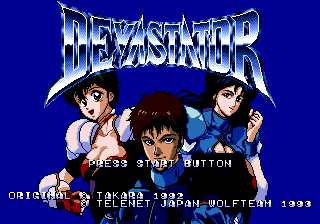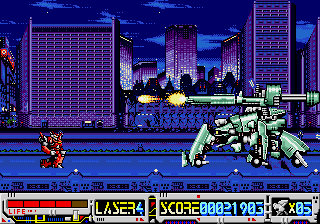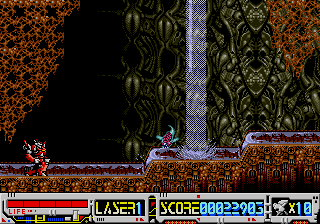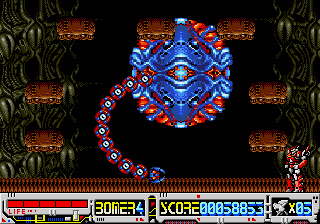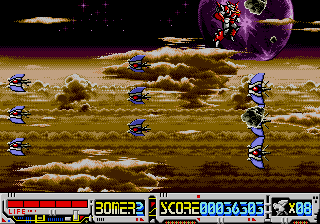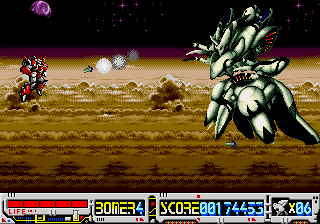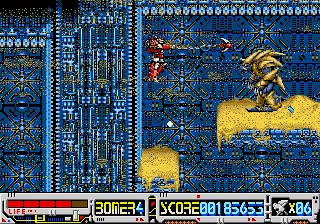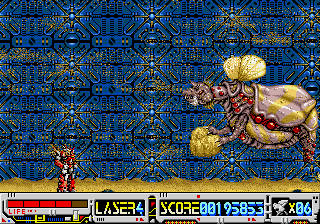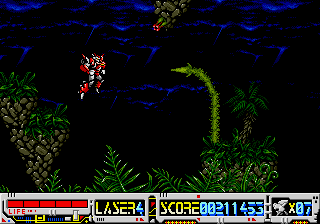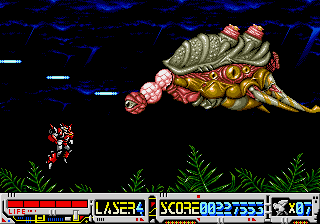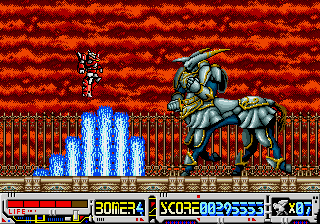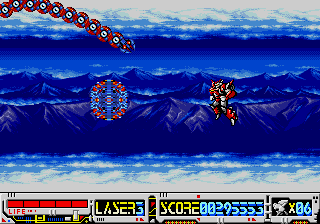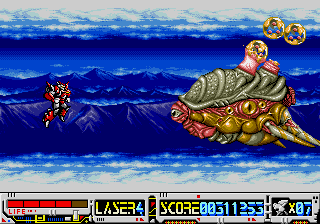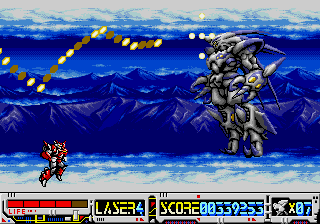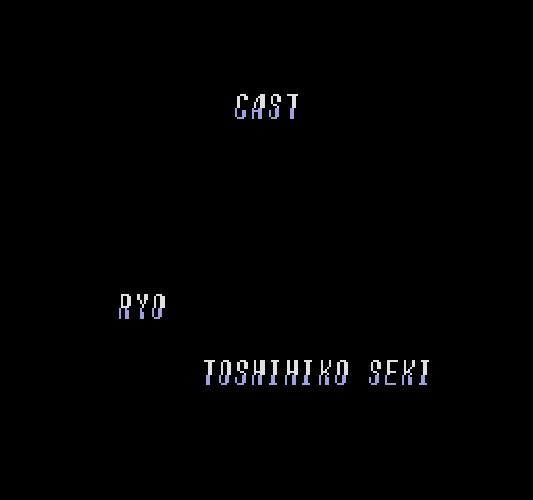Devastator
From Sega Retro
| Devastator | |||||||||||||||
|---|---|---|---|---|---|---|---|---|---|---|---|---|---|---|---|
| System(s): Sega Mega-CD | |||||||||||||||
| Publisher: Wolf Team | |||||||||||||||
| Developer: Wolf Team, Telenet Japan | |||||||||||||||
| Distributor: Samsung (KR) | |||||||||||||||
| Genre: Shooting[1] | |||||||||||||||
| Number of players: 1 | |||||||||||||||
|
Devastator (デバステイター) is a Sega Mega-CD game that mixes platforming action and horizontal shoot-'em-up sections, developed by Wolf Team and Telenet Japan. It was only released in Japan and South Korea.
The game is based on the OVA anime D-1 Devastator and features various anime sequences.
Contents
Story
A mysterious organic tower has appeared on the Tokyo waterfront and destroys the city with its eerie magnetic emanations. It is discovered that the tower is being used to merge the planet with a parallel dimension that is filled with demonic creatures called Devastators. While the worlds are merging, it is possible to travel between them by reaching 300 kilometers per hour.
A young man named Ryo Yatabe (ヤタベ・リョウ) is investigating the disappearance of his friend Kenjo Masato (ケンジョウ・マサト), who was working as a test driver for the advanced vehicle company Yaesu Industries (ヤエス工業). The chairman of the company, Gray Gear (グレイ・ギア), invites Ryo to the Yaesu test course, where Ryo test drives the same vehicle as Masato, the Vector Versus (ヴェクターバーサス). He is able to exceed 300 kilometers per hour and finds himself warped into a strange world where he is immediately attacked by monsters. He is rescued from the Devastators by a group of mecha pilots, who are fighting to prevent a nefarious supranational army called NADO from creating a permanent connection between the world of the Devastators and our own. Ryo learns that Yaesu has been aware of the alternate dimension and has developed countermeasures to fight the Devastators, including the Vector Versus, which can transform into an armed robot.
Characters
Gameplay
The game takes place in a cyberpunk world. The player pilots a giant red mechanoid named the Vector Versus (ヴェクターバーサス), which switches between walking for platforming stages and flying for shoot-'em-up stages. There are cutscenes in between the stages that were taken from the source anime.
In the platforming stages, the mecha walks with ![]() or
or ![]() . It kneels with
. It kneels with ![]() and jumps with
and jumps with ![]() . It attacks with
. It attacks with ![]() or
or ![]() , which whips an anchor-shaped blade at the end of a chain. It is also augmented by a special attack, which is initially shooting a spreadshot but can be changed by collecting items. The attack can be done while kneeling or jumping, and it can be aimed upwards with
, which whips an anchor-shaped blade at the end of a chain. It is also augmented by a special attack, which is initially shooting a spreadshot but can be changed by collecting items. The attack can be done while kneeling or jumping, and it can be aimed upwards with ![]() +
+![]() /
/![]() or downwards (while in midair) with
or downwards (while in midair) with ![]() +
+![]() /
/![]() . The mecha can also dash forward while kneeling with
. The mecha can also dash forward while kneeling with ![]() +
+![]() , which can be used to dodge or pursue enemies or to ram them as an attack.
, which can be used to dodge or pursue enemies or to ram them as an attack.
In the shoot-'em-up stages, the mecha moves in any direction using the D-Pad and turns around with ![]() . It attacks with
. It attacks with ![]() or
or ![]() . Its weapon works the same way as it does in the platforming stages, except it cannot be aimed upwards or downwards.
. Its weapon works the same way as it does in the platforming stages, except it cannot be aimed upwards or downwards.
The mecha has five bars representing its armor and loses one whenever it takes damage. It is destroyed after losing its last armor bar. Losing a life takes the player back to the last checkpoint, with the weapon downgraded by one level, if the player has extra lives left; otherwise, the game ends, but it can be continued an unlimited number of times. There are three difficulty levels (Easy, Normal, and Hard). This modifies the fierceness of enemy attacks (for example, bullets fly faster) but does not affect enemy placement or damage received. The player can change the number of starting lives (between 1 and 9).
Items
Items are dropped by flashing enemies when they are destroyed. Hitting a Life or a weapon item changes it to a different one. The mecha is momentarily invulnerable after collecting an item.
Collecting the same weapon again upgrades the weapon, up to three times. Collecting a weapon item awards 5,000 bonus points if the weapon is already at its maximum level. Collecting a different weapon keeps the weapon level the same.
| ライフ (Life) | |
|---|---|
| Restores one bar of armor to the Vector Versus. | |
| ショット (Shot) | |
| Augments the mecha's weapon with a spreadshot. It is weaker than the other weapons but covers a large area. It initially fires in three directions with one bullet per stream, but it gains an extra bullet per stream at each level and grows to five directions at level 4. | |
| レーザー (Laser) | |
| Augments the mecha's weapon with a helical blast. It is slow-firing but does high damage and can penetrate through multiple targets. Its damage increases with each level. | |
| ボマー (Bomer) | |
| Augments the mecha's weapon with a bomb that is thrown upward, which then separates into a spread of bombs that explode after hitting an enemy or the ground. It has the advantage that it can attack over obstacles. It is initially only one bomb but gains an extra bomb with each level. | |
| ボーナス (Bonus) | |
| Awards bonus points. | |
| ワンアップ (1 Up) | |
| Gives the player an extra life. |
Stages
| City | |
|---|---|
| Platforming stage. | |
| Bio-mechanized | |
| Platforming stage. The boss makes use of the Mega-CD's sprite scaling and rotation capabilities. | |
| Clouds | |
| Shooting stage. | |
| Sand-mechanized | |
| Platforming stage. | |
| Jungle | |
| Shooting stage. | |
| Palace | |
| Platforming stage. | |
| Mountains | |
| Shooting stage. This is a boss rush stage. There is no checkpoint if the mecha is destroyed. |
Production credits
- Ryo: Toshihiko Seki
- Kaoru: Yumi Tohma
- Nami: Meena Tominaga
- Jeldy: Fumi Hirano
- Yamashiro: Kaneto Shiozawa
- Yuuka: Mika Kanai
- Ethiman: Tessyoh Genda
- Game Design: Hiroshi Ogawa
- Main Program: Kazunori Ueno
- Sub Program: Shinji Hirachi
- CD Program: Chikaaki Tokuhiro
- Visual Program: Satoshi Kawabata
- Graphic Design: Tadashi Hamada, Nobuo Kanuma, Hiroshi Uehira, Hidekimi Takezaki, Akihiro Kabaya, Sakadate, K.Karasumaru
- Composition: Motoi Sakuraba, Ryota Furuya, Shinji Tamura
- Original Bill: Sphius.Lab, Toshi Yoshida
- Super Intendence: Tetsuo Isami
- Scenario: Seiji Togawa
- Design Works: Chouji Maboroshi, Yasuhiro Moriki, Hiroyuki Hataike, Mosami Ohbari
- Sound Track: Yoshitetsu Jahana
- Media Mix Coodinate: Junichi Basaki
- Official Report: Emiko Kobayashi, Akinobu Shiratori, Tomoko Murakami
- Manufacture Cooperate: Studio Signal
- Edit: Atsushi Fujimoto, Mitomo VTC., Go Say Do
- Editor: Hiroshi Kohno
- MA: Kohichi Imazeki
- NA: Tamiyoshi Okuda
- Thanks: Yoshiyuki Hirate, Kiyoharu Goto, Isao Kadowaki, Hiroshi Hashimoto, Yugo Akai, Takeshi Ikeda, Tatsuya Tezuka, Naoki Watabe, Masaking, Kazuya Ishizuka, Ryuichi Ishizawa, Toshimasa Hagiwara, Fumio Shimoyama, Kenichi Suzuki, Takeharu Kimura, Mitsutoshi Yasumori
- Special Thanks: Kazuyuki Fukushima
- Assistant Produce: Takeshi Okuda
- Produce: Joe Asanuma, Masaaki Uno
- Exextive Produce: Masahiro Akishino
- Original: © Takara 1992, © Telenet Japan/Wolfteam 1993
Magazine articles
- Main article: Devastator/Magazine articles.
Promotional material
Physical scans
| Sega Retro Average | |||||||||||||||||||||||||||||||||||||||||||||||||||||||||||
|---|---|---|---|---|---|---|---|---|---|---|---|---|---|---|---|---|---|---|---|---|---|---|---|---|---|---|---|---|---|---|---|---|---|---|---|---|---|---|---|---|---|---|---|---|---|---|---|---|---|---|---|---|---|---|---|---|---|---|---|
|
| 54 | |
|---|---|
| Based on 11 reviews | |
| Mega-CD, JP |
|---|
Technical information
- Main article: Devastator/Technical information.
References
- ↑ 1.0 1.1 https://sega.jp/fb/segahard/mcd/soft_licensee.html (Wayback Machine: 2019-06-10 17:56)
- ↑ File:Devastator MCD JP SSEnding.pdf
- ↑ Beep! MegaDrive, "May 1993" (JP; 1993-04-08), page 26
- ↑ Consoles +, "Mai 1993" (FR; 1993-0x-xx), page 118
- ↑ Famitsu, "" (JP; 1993-03-05), page 1
- ↑ Game Power, "Settembre 1993" (IT; 1993-0x-xx), page 99
- ↑ Hippon Super, "May 1993" (JP; 1993-04-03), page 32
- ↑ Mega, "August 1993" (UK; 1993-07-15), page 46
- ↑ MegaTech, "August 1993" (UK; 1993-07-20), page 62
- ↑ Sega Power, "September 1993" (UK; 1993-08-05), page 36
- ↑ Sega Pro, "September 1993" (UK; 1993-08-12), page 78
- ↑ Sega Force Mega, "October 1993" (UK; 1993-08-19), page 116
- ↑ Sega Saturn Magazine, "September 1995" (JP; 1995-08-08), page 87
| Devastator | |
|---|---|
|
Main page | Hidden content | Magazine articles | Reception | Technical information | |
